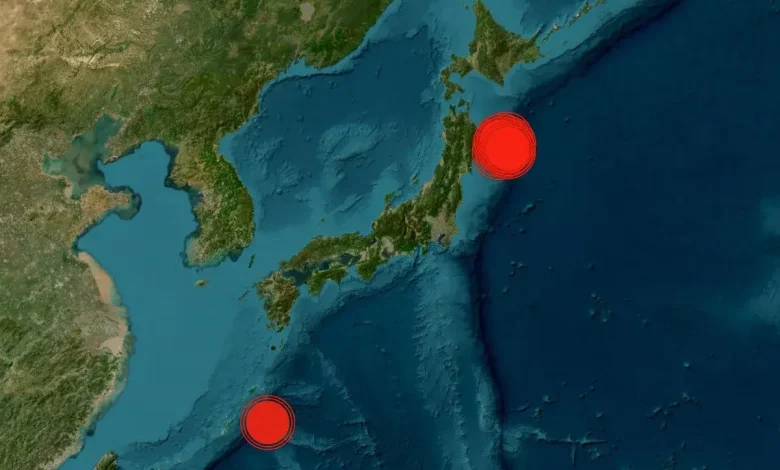Japan Hit With Multiple Earthquakes Following Tsunami Warning

Dozens of earthquakes struck near Japan on Monday following a cluster of seismic activity that rocked the area over the weekend.
Today’s set of earthquakes follow a 6.8 magnitude earthquake that struck off the coast of Japan’s Iwate Prefecture at 5:03 p.m. local time on Sunday that prompted a tsunami warning.
Since then, at least 36 additional quakes have hit in the area, according to data from the U.S. Geological Survey (USGS).
The seismic cluster occurred primarily off the coast of Iwate Prefecture, extending as far north as Hokkaido, according to data from the USGS and the Japan Meteorological Agency (JMA).
Japan’s authorities canceled the tsunami warning on Sunday after several hours but warned of continued seismic risks in the days ahead.
No injuries or damage from these quakes have been reported.
Why It Matters
Japan’s geography places it atop several intersecting tectonic plates within the Pacific “Ring of Fire,” a region responsible for about 90 percent of the world’s earthquakes.
Each year, Japan records nearly 1,500 earthquakes—accounting for roughly 18 percent of all seismic activity worldwide. This latest seismic episode is a stark reminder of the country’s vulnerability to powerful earthquakes and related tsunamis.
The 2011 Tohoku earthquake and tsunami, which killed nearly 20,000 people and precipitated a nuclear disaster at the Fukushima Daiichi power plant, remains a vivid illustration of the devastation such events can cause.
Japan’s government has repeatedly warned its complex coastline is “vulnerable to tsunamis,” prompting significant investments in disaster reduction and emergency preparation.
Several Earthquakes Strike Japan: What We Know
The USGS recorded a series of at least 36 earthquakes over a 24-hour period from Sunday into Monday.
The largest—initially registered as a magnitude 6.9 but later measured at 6.8—struck about 75 miles off Iwate Prefecture’s coast on Sunday, at a depth of approximately 12 miles. The JMA and USGS immediately issued a tsunami advisory, warning that waves up to 3 feet could reach land in Iwate Prefecture and possibly impact adjacent areas.
Minor tsunami waves—about 8 inches—were subsequently recorded at Kuji and Ofunato, while Ofunato also registered a smaller wave at 4 inches, CBS News reported.
The initial tsunami warning was downgraded roughly three hours after the largest quake, with the hazard revised to a “forecast” for only minor sea-level changes.
Japanese authorities continued to advise vigilance and caution due to ongoing aftershocks. Disruptions included suspended bullet train services and at least one reported power outage in the region.
What Causes an Earthquake?
Earthquakes occur when energy stored in the Earth’s crust is suddenly released, causing seismic waves that shake the ground.
Japan’s ongoing seismic activity results from its position atop the intersection of four tectonic plates: the Pacific, Philippine Sea, Eurasian, and North American plates.
Subduction—the process where one plate moves beneath another—plays a major role in generating large earthquakes around the Japanese archipelago.
The “Ring of Fire” pathway beneath the Pacific Ocean causes frequent and often severe tectonic movements, making Japan one of the world’s most earthquake-prone countries.
As noted by Japan’s government and scientific organizations, the geological interplay in this region is responsible for frequent earthquakes and the potential for tsunamis, especially following strong undersea quakes.
When Was the Tsunami Warning in Japan?
Authorities issued a tsunami warning on Sunday following the magnitude 6.8 earthquake at 5:03 p.m. local time off Iwate Prefecture.
The advisory remained active for approximately three hours, during which minor waves were observed along the coast. Officials downgraded the alert after fears of more significant waves subsided, but maintained ongoing advisories regarding caution and aftershocks.
Historical memory in Japan remains highly sensitive to such warnings. In 2011, a magnitude 9.0 earthquake with a resulting tsunami devastated much of Japan’s northeast coast and led to lasting infrastructure and environmental impacts.
What People Are Saying
Japanese Prime Minister Sanae Takaichi wrote in an X post on Sunday: “At around 17:03, an earthquake with its epicenter off the Sanriku coast occurred. Seismic intensity 4 was observed in Iwate Prefecture and Miyagi Prefecture, and an information liaison room has been immediately set up in the Prime Minister’s Office. A tsunami advisory has been issued, so please evacuate away from the coast immediately. The tsunami that may arrive later could be larger than expected, so please stay alert for further information. Additionally, aftershocks are possible, so please remain cautious of any strong shaking.”
What Happens Next?
Japan’s authorities have lifted the tsunami advisories but continue to urge vigilance for aftershocks.
The JMA stated that the risk for significant tremors remains highest within the next two to three days, although lesser aftershocks may continue for up to a week.
Meanwhile, nuclear facilities have been declared safe. Monitoring and emergency services remain active as seismic activity in the region persists.
Update 11/10/25, 3:35 p.m. ET: This story has been updated with more information.





